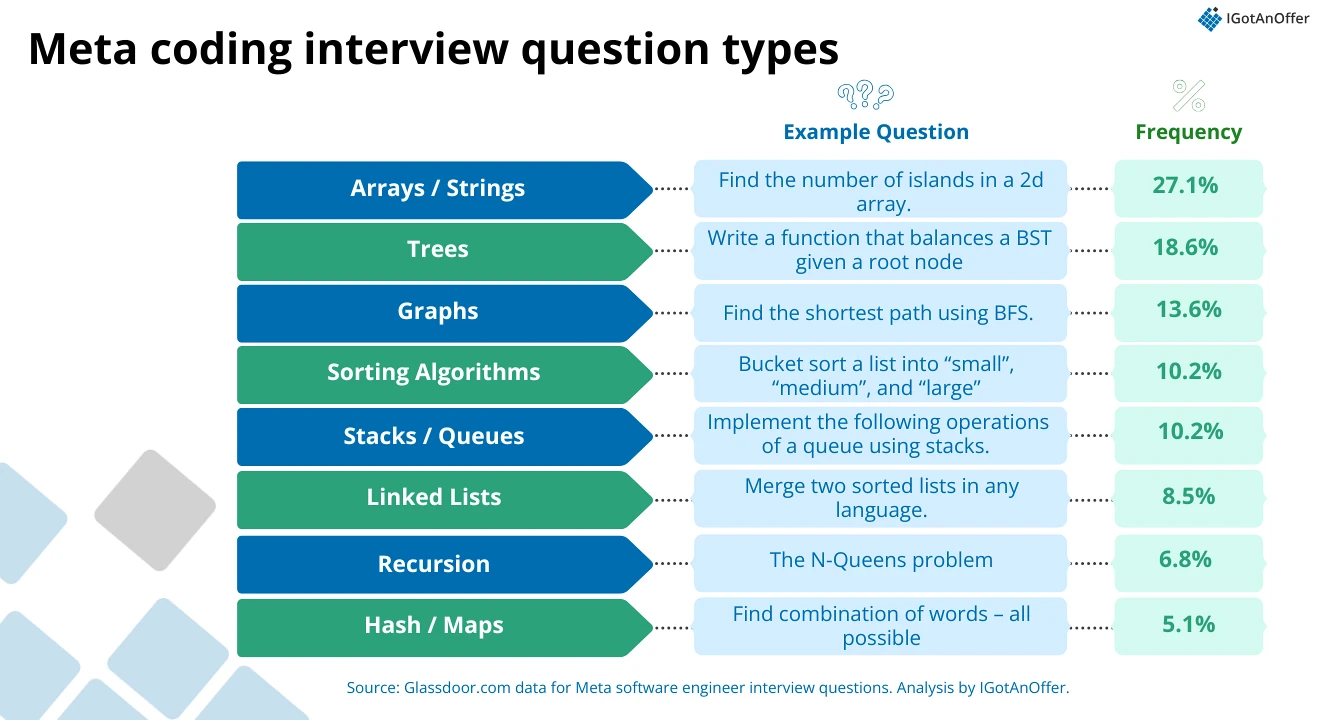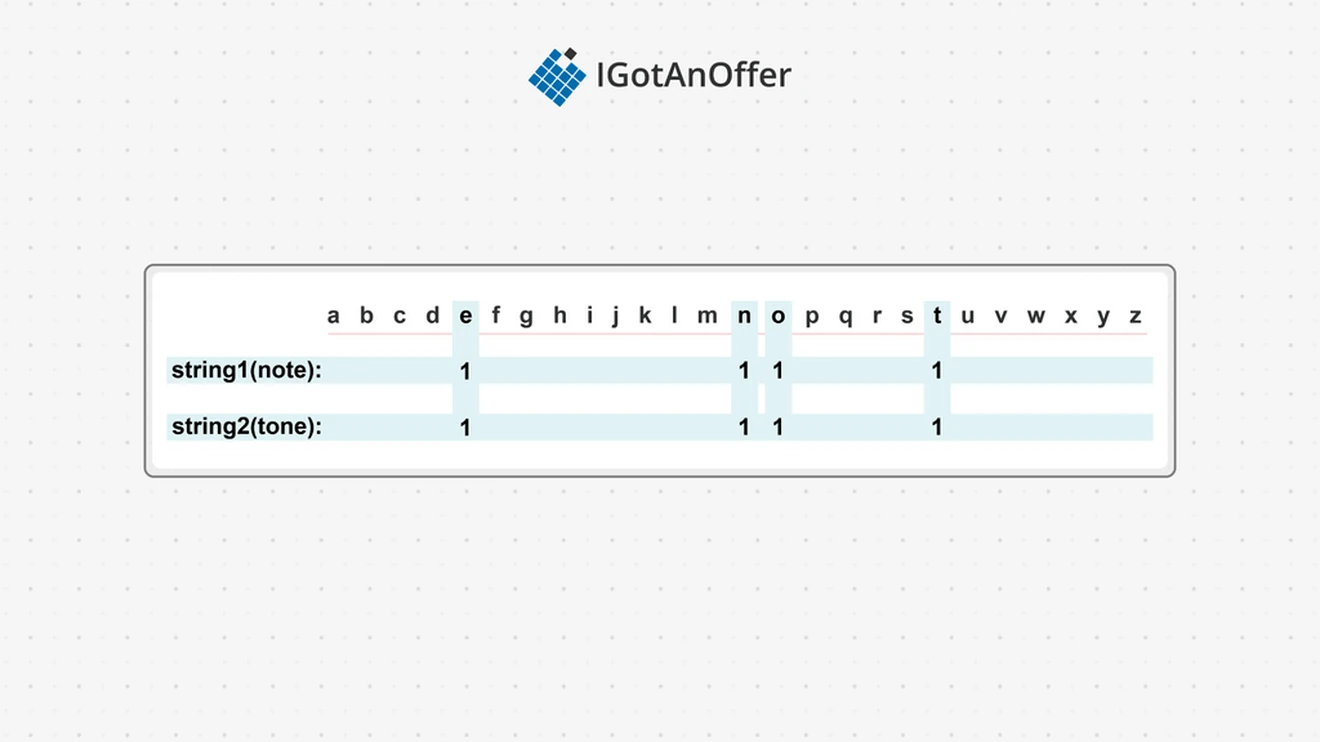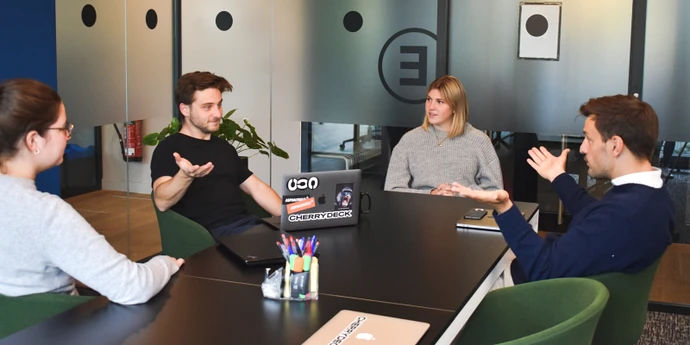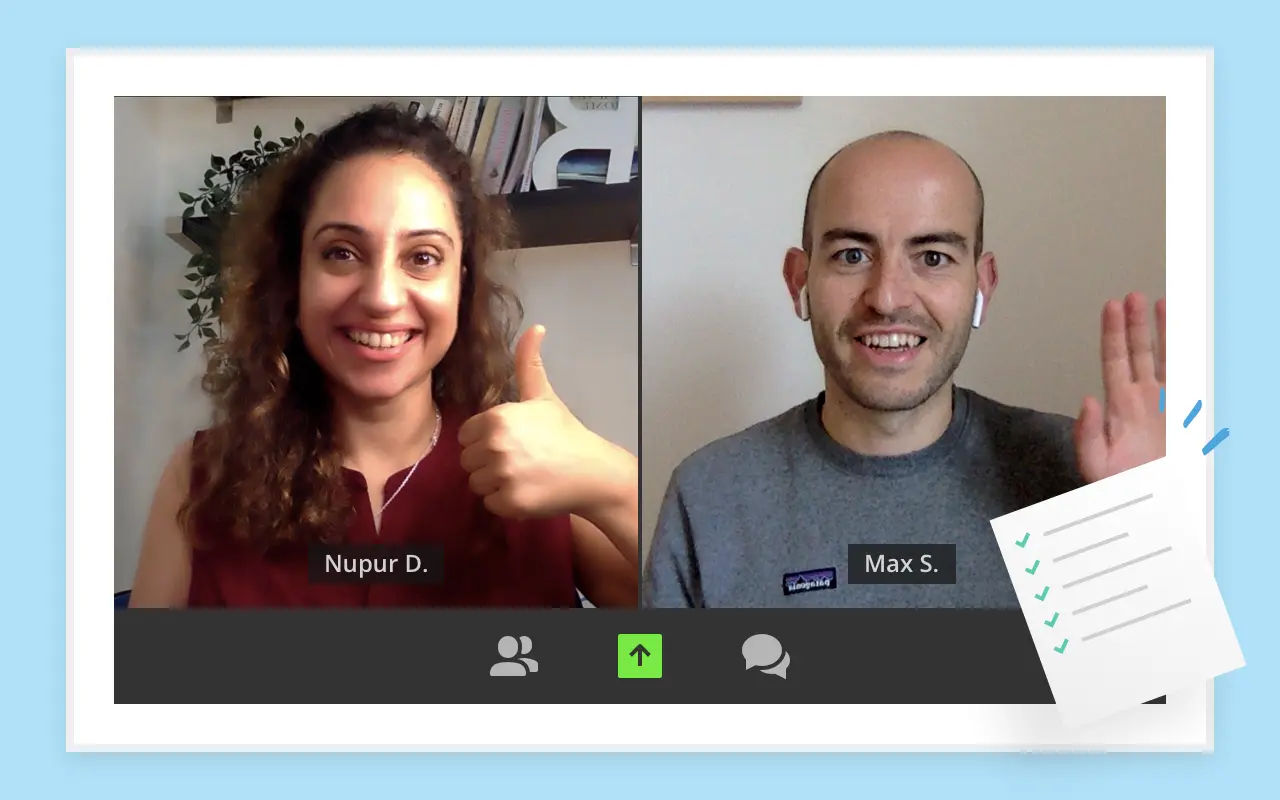Meta coding interview questions are challenging and quite different from problems you would encounter in the real world. Interviewers use them to assess your problem-solving skills, as well as the depth and range of your coding knowledge.
To help you ace your Meta coding interview, we’ve put together this guide. We give you an overview of what to expect, including details on the new AI-enabled coding round, plus the topics you’re most likely to encounter and example questions from real candidates. We also recommend an effective answer framework and a simple prep plan.
Whether you’re applying for software engineer, machine learning engineer, production engineer, data engineer, research engineer, or other technical roles at Meta, you’ll find this guide a great place to start with your prep.
- What to expect
- Meta coding interview question examples
- How to answer Meta coding interview questions
- Meta's AI-enabled coding round
- How to prepare for Meta coding interviews
Let’s get started!
Click here to practice 1-on-1 with an ex-Meta interviewer
1. What to expect
Let’s first look into a couple of details about Meta coding interviews: when you’ll face them, and how they work at Meta, specifically.
1.1 When will you face a coding interview↑
If you’re applying for an engineering role at Meta, you can expect to face coding interviews during your tech screen and full interview loop. You'll also likely get an online coding assessment.
The number of coding problems you’ll have to solve depends on the stage of the interview and your target role.
For the Meta software engineer role, for instance, you have 35 minutes to solve 2 coding problems during your tech screen. When you advance to the full interview loop, you’ll get 2 more coding problems and 40 minutes to solve both.
In addition to coding interviews, many candidates on Glassdoor report doing an online coding assessment as part of or before their recruiter screen. According to this Reddit post, it’s a 90-minute proctored round on CodeSignal, requiring you to keep your video and mic on. You’ll get a base problem with 4 stages, and you’ll need to pass each stage to proceed to the next.
Below are the other top engineer roles at Meta and the number of coding interviews you’ll face at each stage of the process:
Meta coding interviews for tech roles
Meta machine learning engineer:
Tech screen: 35 minutes, 1 to 2 questions
Interview loop: 40 minutes, 2 questions
Tech screen: n/a
Interview loop: 40 minutes, 1-2 questions
Tech screen: 25 minutes, up to 5 questions
Interview loop: 1 hour, 1 to 2 questions
Tech screen: 45 minutes, 1 to 2 questions
Interview loop: 45 minutes, 2 questions
1.2 How coding interviews work at Meta↑
Meta's engineers across disciplines use code to solve some of the most difficult problems the company faces.
As a result, it's essential for all of the company's new engineers to have strong foundational coding skills.
That doesn’t mean you’re expected to get perfect marks during your coding interviews.
Instead, according to Meta, you’ll be assessed on the following:
- Communication skills. During your Meta coding interviews, you’ll encounter ambiguous problems, so you’ll want to ask clarifying questions before going into problem-solving mode. You’re also expected to talk through your process while coding, and listen for hints when your interviewer offers them.
- Problem-solving skills. Your Meta interviewers will want to get an idea about how you approach complex problems.
- Coding structure and style. You’re not expected to code flawlessly. But what your Meta interviewers will be on the lookout for is your ability to translate your solutions into executable and organized code with the right logical structure.
- Verification. Lastly, your Meta interviewers want to see how you review your own code. If you spot a bug in your code, they want to see how you plan to work your way through debugging.
Apart from these role-relevant skills, here are a couple of interview-specific skills you need to ace your Meta coding rounds, according to Thang, ex-Meta senior data engineer.
- Solving a coding problem in 20 minutes or less. In real life, you won’t be expected to solve coding problems within such limited time constraints. But for coding interviews, you’re only allotted 40 minutes to solve 2 problems. So you’ll want to time yourself during your practice to get used to the fast pace.
- Coding manually. Thang says that one of the most common mistakes candidates make is that they’re not prepared to run their code manually. During your Meta coding interviews, you’ll only be allowed to code on a plain text editor like CoderPad (for phone or virtual screens) or a whiteboard (for in-person interviews), so you’ll have to practice coding on these formats.
For coding language, only the data engineer role specifies a language (Python) for its coding rounds.
As for the SWE and other engineer roles, you’re encouraged to code in the language you’re most confident in. Let your recruiter know which language you’ll be coding in so they can inform your interviewers.
2. Meta coding interview questions↑
Now let’s get into the coding interview questions you can expect at Meta.
According to Thang, you’ll typically get medium to difficult coding problems during your Meta coding interviews.
Many of the Meta SWE candidate reports on Glassdoor confirm this. The difficulty level goes up as you advance in the interview process.
The Meta tech screen guide lists 8 data structure and algorithm (DSA) topics that you’ll likely encounter in your coding interviews. Based on our analysis of the 50 most recent coding questions reported on Glassdoor, here’s how frequently each topic gets asked:

- Arrays & strings 27.1%
- Trees 18.60%
- Graphs (BFS & DFS) 13.60%
- Sorting algorithms 10.20%
- Stacks & queues 10.20%
- Linked lists 8.50%
- Recursion 6.80%
- Hash & Maps 5.10%
Let’s take a look at each DSA topic, plus some coding question examples from real candidate reports.
2.1 Arrays & Strings↑
An array is a list-like data structure that contains a collection of values, each associated with a specific index, usually with a fixed overall size. Arrays are one of the most fundamental data structures in programming and computer science, and many more complex data structures are built using arrays.
A string is an ordered sequence, or string, of characters. It is usually considered a data type and is often included as part of language primitives. In most languages, strings are implemented using an array of bytes. The bytes are encoded using some character encoding. Earlier systems used ASCII encoding, with Unicode encoding used in later systems.
Arrays and strings are two of the most fundamental data structures used in coding. Meta asks questions related to these two topics to discern if you’ve got strong foundational skills.
Here are some example questions reported by SWE candidates on Glassdoor:
Meta coding interview example questions: arrays & strings
- Longest repeating substring with replacement (Solution)
- Find the number of islands in a 2d array. (Solution)
- Given a string of an arithmetic expression, composed of numbers, '+' and '*', calculate the result. (Solution)
- Given an array
numsof n integers where n > 1, return an arrayoutputsuch thatoutput[i]is equal to the product of all the elements ofnumsexceptnums[i]. (Solution) - Given a non-empty string
s, you may delete at most one character. Judge whether you can make it a palindrome. (Solution) - Implement
next permutation, which rearranges numbers into the lexicographically next greater permutation of numbers. (Solution) - Given a string S and a string T, find the minimum window in S which will contain all the characters in T in complexity O(n). (Solution)
- Given an array of strings strs, group the anagrams together. (Solution)
- Given a string s containing just the characters '(', ')', '{', '}', '[' and ']', determine if the input string is valid. (Solution)
- Given an array
numsof n integers, are there elements a, b, c innumssuch that a + b + c = 0? Find all unique triplets in the array which gives the sum of zero. (Solution)
Check out our guides on array interview questions and string interview questions to learn more about the topics.
2.2 Trees↑
A tree is an abstract hierarchical data structure. It is represented by a group of linked nodes, with a single root node. Each node can have zero or multiple children. A leaf is a node with no children.
Trees, like arrays & strings, are fundamental data structures used in coding and therefore are common topics for Meta SWE interviews.
Here are some example questions reported by SWE candidates on Glassdoor:
Meta coding interview example questions: trees
- Find the lowest common ancestor in a binary search tree (Solution)
- Write a function that balances a BST given a root node. (Solution)
- Flip a binary tree (Solution)
- Given the
rootnode of a binary search tree, return the sum of values of all nodes with value betweenLandR(inclusive). (Solution) - Given a Binary Tree, convert it to a Circular Doubly Linked List (In-Place). (Solution)
- Implement an iterator over a binary search tree (BST). Your iterator will be initialized with the root node of a BST. (Solution)
- Given a binary tree, you need to compute the length of the diameter of the tree. (Solution)
- Serialize and deserialize a binary tree. (Solution)
- Given a binary tree, find the maximum path sum. (Solution)
- Given a sorted dictionary (array of words) of an alien language, find order of characters in the language. (Solution)
Click here to learn more about tree interview questions.
2.3 Graphs (BFS & DFS)↑
A graph is an abstract data structure represented by vertices connected by edges. Vertices are also known as nodes. Vertices sharing an edge are known as adjacent.
There are two main strategies to traverse graphs, namely depth-first search (DFS) and breadth-first search (BFS).
When giving out problems related to graphs in a coding interview, your Meta interviewer wants to verify that you have a strong understanding of graphs data structures and know how to implement graph algorithms like DFS and BFS.
Here are some example questions reported by SWE candidates on Glassdoor:
Meta coding interview example questions: graphs (DFS & BFS)
Check out our articles on graphs, DFS, and BFS to learn more about the topics.
2.4 Sorting algorithms↑
Many algorithms require, or perform better on, a sorted dataset. Take searching as an example: to search an unsorted dataset of 1,000 items means looking at all 1,000 items in the worst case.
In contrast, using binary search on a sorted dataset of 1,000 items means looking at 10 items in the worst case. For a bigger dataset of 1,000,000 items, searching it as unsorted is looking at 1,000,000 items at worst, but searching it as sorted is looking at 20 items at worst.
Being able to sort data effectively can therefore yield returns later in an algorithm.
You’re not required to memorize every sorting algorithm out there. But to ace your Meta coding interview, you should at least know the most common, including merge sort, insertion sort, and quick sort.
Meta coding interview example questions: sorting algorithms
Click here to learn more about sorting algorithm questions.
2.5 Stacks & queues↑
Stacks and queues are similar and complementary in many ways. Both are a sequenced collection of elements that are generally accessed one element at a time and are implemented using similar data structures.
Stacks are Last in First Out (LIFO) constructs. Queues are the opposite, being First In First Out (FIFO) constructs. These characteristics are what give these structures their name. A stack is analogous to a stack of physical objects. Similarly, for a queue, the first person to enter a queue is usually the first person served.
You might be tempted to try to read all of the possible questions and memorize the solutions, but this is not feasible. Your interviewers at Meta will always try to find new questions or ones that are not available online.
Instead, you should use the example questions below to practice the fundamental concepts of stacks and queues.
Meta coding interview example questions: stacks & queues
- Basic Calculator IV: Given an expression such as expression = "e + 8 - a + 5" and an evaluation map such as {"e": 1} (given in terms of evalvars = ["e"] and evalints = [1]), return a list of tokens representing the simplified expression, such as ["-1*a","14"] (Solution)
- Find the matching brackets to balance the open and closed brackets (Solution)
- Implement the following operations of a queue using stacks. Note: see more details at the following link. (Solution)
Click here to learn more about stacks and queues interview questions.
2.6 Linked lists↑
A linked list is a data structure used to store a collection of data elements. In this way, it is similar to an array.
However, unlike an array, the data elements in a linked list do not need to be stored contiguously in memory. Rather, each node in a linked list has a pointer or reference to the memory location of the next node in the list. This means that linked lists do not have a fixed size like arrays and can easily grow and shrink as elements are added or removed.
Here are a some example questions reported by SWE candidates on Glassdoor.
Meta coding interview example questions: linked lists
Click here to learn more about linked list interview questions.
2.7 Recursion↑
Recursion is a process wherein you make a function call itself directly or indirectly. It is one of the most fundamental ways to solve a coding problem and requires that you break down a complex problem into subproblems.
Aside from recursion, you should practice using other algorithmic techniques like divide-and-conquer and iteration. In some cases, the most important step in your problem-solving could be deciding on an algorithmic technique.
Dynamic programming is one of the algorithmic paradigms closely associated with recursive thinking. But according to Meta’s tech screen guide, they don’t ask DP questions.
Here are a couple of example questions reported by SWE candidates on Glassdoor.
Meta coding interview example questions: recursion
2.8 Hash & maps↑
A map is a data structure that allows us to access a value by key. This is in contrast to an array that allows us to access a value by index.
A common kind of map is a hash map (also called a hash table), which stores keys along with associated values (for example, a telephone directory, which associates phone numbers with names).
Maps are more complex compared to the other data structures you’ll be asked about in your Meta coding interviews. But having a good working knowledge of maps is essential for engineers working at a company like Meta, which requires efficient and versatile solutions to run its large-scale systems.
Here are a couple of example questions reported by SWE candidates on Glassdoor.
Meta coding interview example questions: hash & maps
Click here to learn more about map interview questions.
Real Meta Interview Experience
Eric got an offer for a remote senior software engineer role at Meta in 2021. Here’s how he prepped for his coding interview:
“I spent about 100 hours preparing, spread unevenly over 10 weeks.
For coding: I started with random Leetcode problems to get a ballpark of my current level. Using a stopwatch to see how many medium-level problems I could solve in 20 minutes, I realized I needed to practice nearly every study area as my current speed wouldn't get me through a single real interview.
I captured the list of the 12+ styles of questions that could be asked. I then practiced/studied a couple of hours before or after the workday and on weekends. Any question that took me over 30 minutes to solve I would mark down to reattempt in later weeks.
After I got more familiar with approaches, I would skip actually coding the answers when a problem used a near similar approach I already solved.
After my self-study was completed, I completed the Grokking the Coding interview course, and then scheduled a practice coding interview to validate that I was ready and could perform against pressure. The result of that interview had me adjust my final studies to better understand a long list of core data structures so I could deal with verbal questions as I was coding.”
Learn more about what a real Meta interview experience is like, with stories and prep strategies from successful Meta candidates.
3. How to answer Meta coding questions↑
In this section, we’ll give you an answer framework for Meta coding interviews and an example answer using the framework.
We’ll also give you a rundown of what we think differentiates a good vs. great Meta candidate during coding interviews.
Let’s begin.
3.1 Meta coding interview framework↑
To learn how to answer Meta coding interview questions, you must first be able to approach them systematically. You might solve a coding question in different ways, but at the end of the day, you need an approach that will consistently:
- Show your interviewer that you have the knowledge they need
- Break the problem down into manageable steps
Here’s a step-by-step approach that we highly recommend:
- Clarify
- Plan
- Implement
- Test & optimize
Below we’ll go into each step in detail. Let’s get started.
3.1.1 Clarify
Don’t jump straight into the question without consulting your Meta interviewer. Instead, start by asking questions to remove any ambiguity and to explore the edges of the problem.
This is a good time to set up a dialogue with your interviewer. They are not just looking for a candidate who can solve a problem, but one who can work effectively in a team of other Meta engineers.
Let’s jump into how this will look during the interview.
Understand the question
If the question has been written down for you, take the time to read it thoroughly at least twice, to be sure that you’ve picked up on all the details.
Repeat the question back to the interviewer in your own words, so that they can flag anything that you may have initially misunderstood.
Ask clarifying questions
Once you’re sure that you understand the basic question, clarify the unwritten details. For example, ask for constraints (e.g. 0<= N < 1000), consider edge cases, identify corner cases, specify what language you’ll be coding in, etc.
Specify assumptions
Finally, before starting work on the solution, consider any assumptions you’re making (e.g. input format, range, sorted or unsorted list, etc.). Specify these to the interviewer so that they can tell you if that is a correct assumption to make, given the problem.
3.1.2 Plan
Now that you have a complete understanding of the coding question, it’s time to start making your plan. Here is where you can discuss potential approaches with the interviewer, pick the most appropriate one, and lay out the high-level steps to get there.
Let’s take a look at how this will play out in the interview:
Find a solution
Take a few minutes to think through a solution to the problem. It does not need to be optimal at this stage. Map out your solution on the whiteboard or its virtual equivalent, making sure that what you add is comprehensible to both you and the interviewer.
The goal is to find any solution (at least brute-force) and then find improvements. Keep walking through your steps out loud so that the interviewer can guide you.
Explain your solution
Before you implement your plan, make sure that you’ve brought your interviewer up to speed. If you’ve identified multiple approaches to the problem, go over each and explain why you’ve chosen the one you decide to move forward with.
Ensure that the interviewer is aligned with your solution before you start coding. This will help you save time down the road and allow your interviewer to capture the right data points during your coding.
3.1.3 Implement
Now it’s time for the main event. Write legible, clean code rather than pseudocode, and comment out loud on what you’re doing.
Alternatively, if you have a hard time talking and writing, you can spend a few minutes coding quietly, then stop periodically to explain what you’ve done.
Optimize the solution
Once you’ve talked through your solution with the interviewer, optimize it. Consider any points you may have missed when you first thought of the solution and what you can do to make it better.
Explain your reasoning thoroughly and keep an eye out for the cues of the interviewer, which will let you know whether or not you’re on the right track. You can prompt them by asking, “How does that sound?” before moving on to coding.
Write the code
Now, write that code! Explain what you’re doing, and make an effort to write clearly—don’t use shorthand variables. Include descriptive variable names, structure the code well, consider boundary conditions or empty inputs, etc.
Make your code modular and eliminate duplicate code. If you realize you’ve forgotten an important function, simply go back and insert it while clarifying what you’re doing out loud.
3.1.4 Test and optimize
Once you have your code on the board, you’ve got to take the time to run through and test it, then optimize it given what you’ve found in testing. Start by testing with a simple example, then try breaking your code with edge and corner cases.
Don’t forget to calculate the time and space complexity of your code and discuss how you can possibly improve it. If you find any better solutions while testing and evaluating your code’s complexity, ask the interviewer if they’d like you to implement it.
Here’s how that will play out:
Test run your code
When testing your code, run it through multiple cases, starting with the basic use case, moving into a more complex case, and finally test for failure and edge cases.
Consider anything that might break your code and what you can do to address it [e.g. test cases like asserrEquals(findMax(10,20), 20)].
Optimize your code
Finally, work out the time and space complexity of your code. Explain it in simple terms to your interviewer, and use it as a jump-off point to consider ways you can optimize your code.
If time permits, write out the optimal code and discuss it.
Q&A
These last few minutes of the interview are a good time to ask any questions you might have about the company and what your experience would be like working there.
The interviewer may have additional questions for you as well. If the interviewer has clearly moved on from the coding problem, consider it finished and do not try to rehash any of its finer points.
Now that you’ve seen a breakdown of a coding interview flow, let’s take a look at a full example answer.
3.2. Example Meta coding interview answer↑
To illustrate the framework discussed above, we’ve laid out an example answer to a real coding question that was asked in a Meta software engineer interview, according to data from Glassdoor.
Try this question:
"Find out if two given strings are anagrams."
Coding sample answer:
Step 1: Clarify
Understand the question ↑
Candidate: “Okay great. So the problem requires two strings to be compared to establish whether they are anagrams, right?”
Interviewer: “That’s right.”
Ask clarifying questions ↑
Candidate: “May I ask a few clarifying questions?”
Interviewer: “Sure, go ahead.”
Candidate: “I understand an anagram as being two words made up of exactly the same characters, but in a different order, correct?”
Interviewer: “Yes, that's correct. If you can make one of the words by rearranging the order of characters in the other, they are anagrams.”
Candidate: “Can we assume that case does not matter? And if the two strings are exactly the same, do we consider those anagrams?”
Interviewer: “Yes, it can be case insensitive, and the same word can be considered an anagram.”
Candidate: “Great, thanks. I'm just thinking about what else could be relevant to know...”
Interviewer: “No problem, take some time.”
Candidate: “Oh—one more edge case: are two empty or null strings considered anagrams?”
Interviewer: “For the purposes of this question, yes they can be considered anagrams.”
Specify assumptions ↑
Candidate: “Okay. One last question, can I assume that there will be no whitespace or punctuation in either string?”
Interviewer: “Yes, you can make that assumption.”
Step 2: Plan
Find a solution ↑
Candidate: “Okay, so I can think of one way off the top of my head to solve this.”
Interviewer: “Let's go ahead and walk through it.”
Candidate: “I'm thinking that since the characters are the same in each string, but the order is not, we could sort both strings and then compare them to see if they are equal.”
Explain your solution ↑
Interviewer: “Cool, sounds like a quick win. What would the time complexity of that approach be?”
Candidate: “Hmm, so for the compare part, it would be O(n) as we need to run through each index of the strings. For the sort part, if we assume a fast sort is implemented, it would be O(nlogn). So in total O(nlogn) time.”
Interviewer: “Sounds about right. That is a quick win programmatically, but is there another way to get better time complexity?”
Candidate: “Well, since the most significant part of the time comes from the sorting part, we'd need to find a solution that eliminates that part.”
Interviewer: “Sounds reasonable.”
Candidate: “So I'm thinking that I can create a kind of ‘scoreboard’, where I have a list of all possible characters, and keep count of the number of times a particular character occurs in each string. Something like this, where string1 is ‘note’ and string2 is ‘tone.'”

Candidate: “Then, I just need to check if the score of each character is the same for each string. The scoreboard can be implemented as an array, with the indices of the array representing each possible character, and the value at each index the difference between that character's count in each string. Although, in this solution, I’m assuming that only the characters in the set ‘A-Z and a-z’ are used in the words. Is that reasonable?”
Interviewer: “Okay, interesting. Yes, let's assume the character set is limited. What is the time complexity now?”
Candidate: “Well, we can loop through both strings once to add to the character score on their scoreboards. So it is O(n) to loop through the strings, and constant time to loop through the scoreboards. The constant time will dominate for strings less than the length of the scoreboard, but for longer strings it will be O(n) dominated.”
Interviewer: “Okay. Do you want to code it up now, and see how it works?”
Candidate: “Sure!”
Step 3: Implement
Optimize the solution ↑
Candidate: “Looking at the solution again, I think I can optimize the scoreboards a little.”
Interviewer: “What improvement do you see there?”
Candidate: “Well, we can combine the two scoreboards into one. For string1 we can add 1 to the score, and for string2, we can add -1 to the score. That way, it's just one loop through the strings, then one loop through the scoreboard array, to see if the score is 0 for each character. A 0 score for all the characters means that the strings are the same. So we save making a scoreboard array for each of the strings by combining them.”
Interviewer: “Sounds good.”
Write the code ↑
Candidate: “Okay, I'm going to implement this in Node.js flavor JavaScript. I'm going to start with a function declaration and some check and edge case handlers:”
Interviewer: “Okay.”
Candidate: “I'm going to create the array for the scoreboard and initialize all the values to 0.”
Candidate: “Now I'm going to loop through the strings, and add or subtract a score for the corresponding character in the scoreboard. To get the correct index to use, I'll get the character code for the current character in the loop. The codes for alphabetical characters start at some non-zero number, I forgot what number exactly, but we'll need to subtract this starting code number so that our character codes translate to a zero-based index.”
Interviewer: “Great, let's see what that looks like.”
Candidate: “I'm just going to look up what the JavaScript function is for getting a character code, it's something like ‘charCode()’.”
Interviewer: “‘charCodeAt()’, I think.”
Candidate: “Yeah, thanks. Okay, here is the code to loop through the strings and increment or decrement the score for a particular character:”
Candidate: “Since I can't remember the character code that ‘a’ starts at, I'm just getting it at runtime and storing it in the constant ‘charOffset’.”
Interviewer: “Good plan.”
Candidate: “Okay, now I just need to check that all the values in the scoreboard are 0. I guess there are a few ways to do this. One is to use a for loop to check each value. Another would be to sum all the elements using the array reduce function and check that the sum is 0. Another would be to use the array find method to find any non-zero values.”
Interviewer: “Yeah, that's a few options. Which are you going for?”
Candidate: “I'm going with the for loop option. It has a slight advantage in that we can return early if a non-zero element is found.”
Interviewer: “Cool. If that's the full code, let's run some test cases.”
Step 4: Test & optimize
Test run your code ↑
Candidate: “Great, let me add some test code.”
Interviewer: “Looks good. What's the output?”
Candidate: “Here it is:”
Interviewer: “Fantastic! Earlier, we made the assumption that the character set was limited. What would the implications be if that were not the case? Let's say all Unicode characters are allowed.”
Optimize your code ↑
Candidate: “All of Unicode is very large, in the region of 150 000 characters I think. That would make the scoreboard array pretty big. It would negatively affect the space complexity of our solution, because it requires a lot of constant space. It would also increase the runtime, as the whole scoreboard array would need to be checked, even though it's unlikely any strings would be anywhere close to the size of the scoreboard array.”
Interviewer: “Yeah, it would bog this down substantially. Is there an optimization for this solution that could mitigate those issues?”
Candidate: “We'd need a way to cut down the size of the scoreboard array, since it will be so sparsely populated with scores. Perhaps if we tried replacing it with a hashmap?”
Interviewer: “Sounds interesting. Can you explain more?”
Candidate: “With a hashmap, we would only need to store scores against characters that actually appear in the strings. The characters found can be the keys, and the score can be the value.”
Interviewer: “Great. Will that change the time complexity?”
Candidate: “Hashmaps are O(1) for lookup, insert and update operations, so it should be on par with the array solution.”
Interviewer: “Great. Can you code the changes in?”
Candidate: “Sure! I'm going to replace the array initialization with an empty object literal, which will serve as the hashmap. We can also remove the ‘charOffset’ constant, as our keys can now be the characters themselves.”
Candidate: “Then I'll need to replace the inside of the for loop to increment or decrement the key value. I'm first going to add a helper function for the cases where the map does not yet have the key, and it needs to be initialized:”
Candidate: “Now I can call that from inside the for loop.”
Candidate: “Then I can update the scoreboard check code. This will need the for loop to change to checking each key in the scoreboard hashmap:”
Q&A ↑
Interviewer: “What's the ‘hasOwnProperty’ line for?”
Candidate: “That's so keys from the default, or base object, are not included in the count check.”
Interviewer: “Good. Ready to test it again?”
Candidate: “Yeah! Let me run it quickly. Okay, here's the output:”
Interviewer: “Looks good! I think we can move on from this problem.”
Candidate: “Great, thanks!”
3.3 Good vs great Meta candidate↑
In order to make the cut when interviewing at Meta, you have to distinguish yourself from other candidates. Giving a good answer won’t be enough to get an offer. You’ll need to give a great answer if you want to make an impact.
So here are some details that make the difference between an interview that is just ok, and one that will impress your interviewer:
A “good” or "just ok" Meta candidate:
- Completely answers the coding questions, but doesn’t interact with the interviewer
- Interacts with their interviewer, but struggles to take hints or change direction when prompted to do so
- Is able to finish the coding problem, but stumbled through their behavioral questions at the start of the interview
- Gets stuck once or twice during the interview and struggles quietly until they are able to move past it
- Offers a complete solution that is difficult to follow
- Comes up with a workable solution after coming to quick conclusions that they haven't verified with the interviewer
- Follows one approach that works, but neglects to examine its tradeoffs or other possible approaches
- Tests the code after being prompted by the interviewer to do so
- Finishes and tests the code by the end of the session, but does not leave time to consider space and time complexity
A “great” Meta candidate:
- Is able to change direction and dive deeper on specific aspects when asked
- Has prepared responses to common behavioral questions and can transition smoothly into the coding portion
- Is able to talk through the problem when they get stuck, attack it from multiple angles, and take hints from their interviewer
- Points out the common pitfalls of the programming language they’ve chosen
- Offers a complete solution that is easy to follow, with clearly defined variables and space for corrections
- Considers multiple approaches to the problem and clearly explains why the one they choose is the most efficient
- Works steadily and methodically, only coming to conclusions after having thought and worked through certain aspects
- Proactively tests the code and identifies bugs before the interviewer points them out
- Examines the space and time complexity of the code, offering to optimize certain aspects where applicable.
Ultimately, being a great candidate boils down to having the right mix of technical knowledge and communication skills to both work out the problem and dialogue with the interviewer. For extra tips on coding interviews, take a look at our list of 21 coding tips from ex-interviewers.
You’ll need to prepare for your Meta coding interview by brushing up on technical concepts and soft skills like communication. We’ve got a preparation plan to help you do that in our next section.
4. Meta's NEW AI-enabled coding round↑
One crucial update to the full interview loop is the use of AI assistance during one of the coding interviews. Here’s what Meta says about this update on their FAQ:
Meta is piloting a new, AI-enabled SWE coding interview to reflect the evolving role of software engineers and where we’re headed in the future. Candidates in the pilot groups will now have the option to use authorized AI tools within CoderPad during one of their coding interviews. The pilot will include one “classic” coding interview and one AI-enabled interview. Interview questions, focus areas, and evaluation criteria are also being enhanced to better reflect the current coding skills required at Meta, such as debugging and code review.
According to John (Meta engineering manager), the AI-enabled coding round lasts for 60 minutes. You’ll be given one thematic question with multiple stages.
"Using it is optional, and you are not evaluated on how often you use it. What matters is your ability to think critically, understand the code, and make informed decisions," he says.
To give you a more detailed understanding, we asked John what you can expect from this round and what you should focus on.
Just a note on our Meta resource expert: John has over 10 years of engineering manager experience, having interviewed 3000+ candidates across software engineering and management roles at Meta and other top tech companies.
Meta AI-enabled coding round
Environment
You’ll get a small project with multiple files. These files may include some helper code, data files, or tests to allow you to focus on reasoning and problem-solving.
You may also get a few hundred lines of existing code or data to give you context and help you avoid superficial solutions.
Not every step involves writing code. You may be asked to analyze runtime behavior, interpret data, justify design choices, or reason about contracts or interface changes.
Structure
You’ll find that the structure of this coding round will be in three parts:
Part 1: Explore and Fix Issues
Begin by reading through the existing files, tests, and data to get a clear sense of how the system works.
Then start examining the existing code and resolving failing tests or small bugs. This should help you warm up and become familiar with the project before moving into larger tasks.
Part 2: Implement New Functionality
Next, you’ll be asked to complete a clear, well-defined requirement, like a new function or feature. For this part, you may implement this yourself or use AI assistance, but you should still be able to understand and justify the final result.
Part 3: Extend and Improve the System
Finally, you’ll need to tackle a broader, open-ended task which may involve:
- modifying existing components,
- adding a more complex feature,
- optimizing performance, or
- adapting the design to new conditions.
There is room for deeper exploration, so to be a strong candidate, you can and should continue advancing the solution.
Meta’s AI-enabled coding round tests for the following foundational skills:
- ability to understand existing code
- debugging skill
- problem-solving
- code quality and maintainability
- logical and clear communication
- capacity to explain and justify decisions
- adaptability when problems expand in scope
John’s advice: “Treat AI assistance as a tool, not a replacement for understanding.” He adds that if you choose to use AI, you should:
- check its logic,
- verify correctness,
- adapt the code as needed,
- and be prepared to explain it.
Overall, you'll still need to display the same foundational skills in the AI-enabled coding round, the way you would need to in a traditional coding interview. In addition to those, you'll also need to demonstrate skills in debugging and code review, which reflect the current skill requirements at Meta.
5. How to prepare for Meta coding interview questions↑
As you can see from the information above, there is a lot of ground to cover when it comes to your Meta coding interview preparation. So, it’s best to take a systematic approach to make the most of your practice time. We recommend the three steps below.
5.1 Practice on your own
Before you start practicing interviews, you’ll want to make sure you have a strong understanding of the relevant algorithms and data structures. Once you’re confident in all of these, practice your skills by working through lots of coding problems.
Here are some resources from Meta’s official interview guides:
- Meta software engineer interview Q&A
- Cracking the Meta coding interview (approach and problem walkthrough)[password: FB_IPS]
- Topcoder
- GeeksQuiz
- DSA coursework (with solutions)
Throughout the article, we've listed a few of our own tech interview guides. Here's a quick summary for your easy reference:
- How to prepare for FAANG coding interviews
- Ultimate data structure interview questions list
- 21 coding tips from FAANG ex-interviewers
You might also want to familiarize yourself with the rest of the interview process for your specific target role.
- Meta Software Engineer interview guide, plus these level-specific Meta engineer interview guides:
- Meta Engineering Manager interview guide
- Meta Data Engineer interview guide
- Meta Machine Learning Engineer interview guide
- Meta Production Engineer interview guide
- Meta Front-end Engineer interview guide
- Meta Technical Program Manager interview guide
- Meta Research Engineer interview guide
While doing your self-practice, you might want to start tracking your progress. FAANG interview coach Himanshi has a checklist that she uses to check her own coding preparedness. We recommend having one yourself.
#Coding interview checklist
- I’ve revised and coded the foundational algorithms — sorting, searching, recursion, greedy, dynamic programming.
- I’ve internalized key data structures — including implementation, complexity, and core operations like traversal and memory handling.
- I’ve built a mind map that links common problem cues to patterns and structures.
- I can consistently go from brute force to optimal for a medium-hard problem in ~15 minutes.
- I can consistently code the solution in ~15 minutes with clean logic and basic test cases.
- I can consistently explain my thought process, solution, and code clearly under time constraints.
- I have taken at least 2-3 mock interviews to practice communication and clarity
Click here to learn how to assess whether you’re ready for a FAANG interview.
Or, if you've already interviewed for a role at Meta and gotten a rejection, that doesn't mean you can't bounce back or try again. Check out our Meta interview rejection guide.
One of the main challenges of coding interviews is that you have to communicate what you are doing as you are doing it. Having to think, code, and communicate your thoughts to the interviewer all at the same time is not easy.
With that in mind, don't let the first interview you do be the real thing. Instead, we highly recommend getting some mock interviews under your belt.
5.2 Practice with peers
If you have friends or peers who can do coding mock interviews with you, that's an option worth trying. It’s free, but be warned, you may come up against the following problems:
- It’s hard to know if the feedback you get is accurate
- They’re unlikely to have insider knowledge of interviews at your target company
- On peer platforms, people often waste your time by not showing up
For those reasons, many candidates skip peer mock interviews and go straight to mock interviews with an expert.
5.3 Practice with experienced coding interviewers
In our experience, practicing real coding interviews with experts who can give you company-specific feedback makes a huge difference.
Thang advises asking your interview coach to simulate the constraints of a real Meta coding interview during your mock interview. That is, solving 2 problems within 40 minutes, without being able to run the code.
Find a Meta coding interview coach so you can:
- Test yourself under real interview conditions
- Get accurate feedback from a real expert
- Build your confidence
- Get company-specific insights
- Save time by focusing your preparation
Mocks are also extremely useful for the other types of interview rounds you’ll be facing at Meta, such as system design and behavioral.
Landing a job at a big tech company often results in a $50,000 per year or more increase in total compensation. In our experience, three or four coaching sessions worth ~$500 make a significant difference in your ability to land the job. That’s an ROI of 100x!















